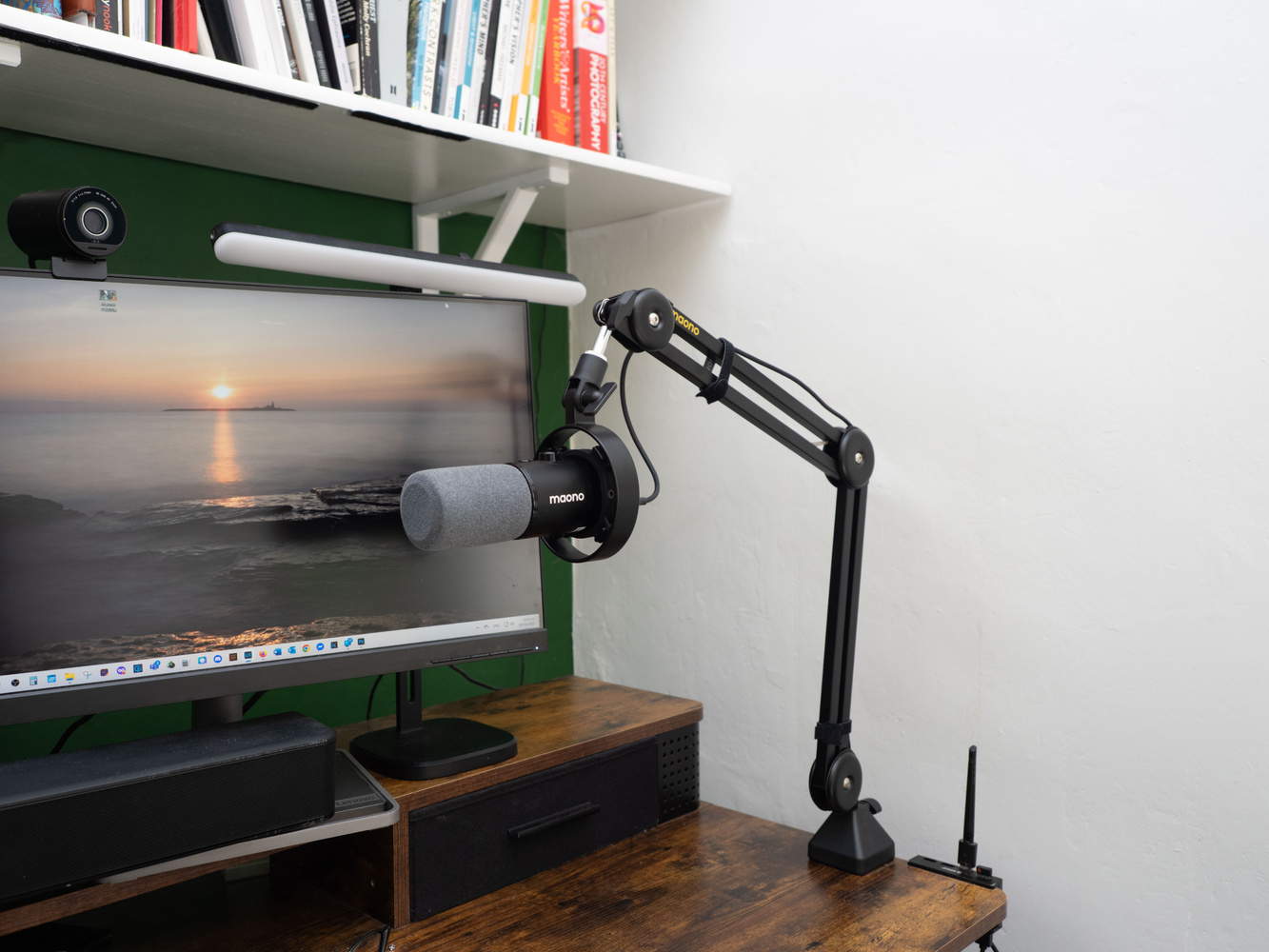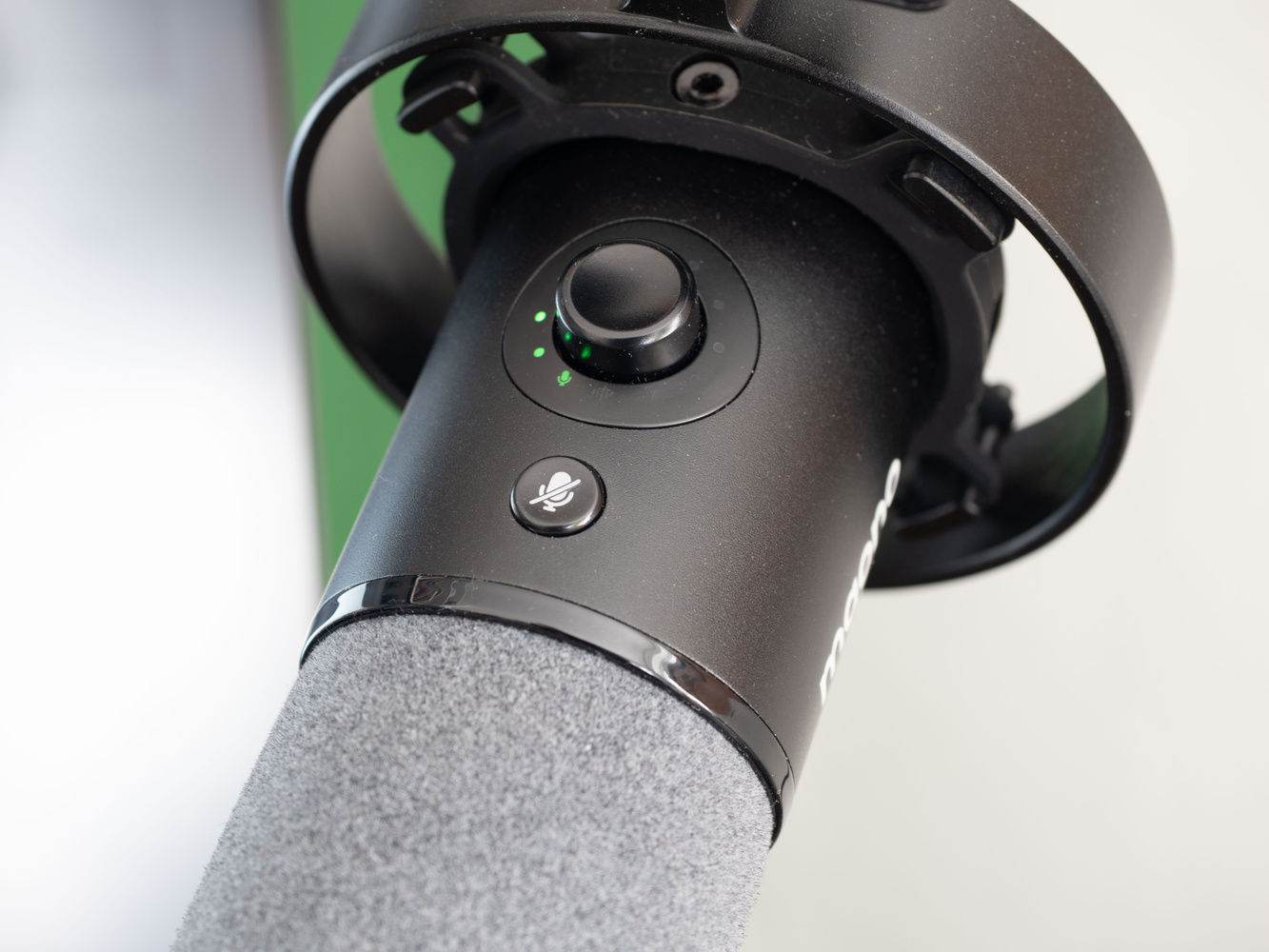Increasingly, I am running presentations or attending Microsoft Teams meetings from my desk. Therefore, it became time to improve the sound setup at my workstation. Maono is a respected name in the field of microphones, and so their PD300X seemed a great choice for me, but how did it fare?
Although I sometimes produce short videos for these reviews—what’s the point of reviewing a microphone if you cannot hear what it sounds like—I don’t consider myself a YouTuber. Therefore, I am not eager to spend many hundreds of pounds (I’m in the UK) on unnecessarily advanced gear.
Recently, I reviewed a Maono wireless lavalier microphone. I was suitably impressed and so was more than happy to risk trying their PD300X microphone combined with the BA37 boom arm.
First Look at the PD300X Microphone
Pleasingly, the mic and boom arrived in cardboard packaging, but the boom had a foam insert useful for storage.
The microphone is built from a multi-coated aluminum alloy. Covering the capsule is a foam pop filter. Behind that is a mute button, and then a multi-function rotating push button. That serves as the mic gain control, the headphone volume, and the monitor mixer. Then, on the rear of the microphone is an XLR output, a USB-C socket, plus a 3.5 mm headphone jack. The mic is secured into a rubber shock mount, onto which is attached the stand adapter.

First look at the BA37 Boom Arm
Like the mic, the stand is made almost entirely of metal. It’s robust and fitted with a heavy spring. At the base, a G-clamp secures the arm to the desk. The arm that swivels on the base comprises three elbow joints and, at the top, the microphone can also rotate and tilt.

Setting Up the Rig
I hardly ever read the instructions. I’m pretty good at working out how things are put together and I am a fan of simplicity. If I need to refer to the instructions, then a device is often needlessly complex. Constructing this was simplicity itself. The mic and arm were out of the boxes and installed on my desk in under five minutes.
The boom arm was supplied with two Velcro cable tidies and the elbow joints have channels to feed the cable around. Those elbows were too tight on receipt and I needed to find a hex key to loosen them.
The mic is plug-and-play, so installing it on my PC just required the USB cable to be plugged in. The box proclaimed that the mic “Made for Apple,” so it also works with the iPhone, iPad, and iPod, meeting Apple’s exacting standards.
The microphone is designed for recording podcasts and therefore should have a good response to vocal frequencies. Indeed, that is the case, and in meetings, others commented that the sound quality was far superior to those using their laptops' built-in microphones or even other desk mics.
It collects sound in a cardioid polar pattern, which means it is designed to be pointed at the person being recorded and is less likely to pick up ambient noises from the room.
On top of the microphone, situated around the gain dial, is an LED array that shows the microphone level. That rotary dial is also a push button, and it can change from adjusting the microphone gain to headphone volume, and monitor mixer. The LEDs change color to indicate which function you are using. This multi-functional knob is easy to operate.

The Accompanying Maono Link Software

The manufacturer produces free software to work with its mics called Maono Link. I downloaded that and ran it on my PC. The current version only works with Windows. The software includes a simple sound recorder with a graphic equalizer that allows you to save your own presets. There are also included presets for different situations like podcasting and gaming.
Usefully, the software also includes a noise gate. It does this by attenuating the sound below the set threshold.
In Use
The microphone was easy to set up and use. The LED level display around the gain knob was bright enough to see without it becoming a distraction. I was really pleased to see that it had a mute button, which is useful for privacy.
As I hinted earlier, the sound quality is great. For speech, recorded voice over my Bose speaker comes over deep and crisp. Men’s voices are generally within the 80 to 180 Hz range, while women typically fall within the range of 165 to 255 Hz.
The microphone claims a 192 kHz / 24-bit sampling rate within a 40 Hz to 16 kHz range. I tested that. At the low end, it indeed detected sounds down to 40 Hz, far lower than the human voice. It also detected sounds I played through my speaker up to 16.5 kHz, way above the range of my poor hearing and far higher than the highest tones created by the human voice, and also 500 Hz higher than the advertised rate.

I haven’t reviewed anything that is perfect, and a reviewer wouldn’t be doing their job properly if they found nothing wrong with a piece of equipment. Nevertheless, I only write reviews of gear I would be happy using, and I’ve sent some stuff back without writing a review because it has been something I would not use nor recommend. With this mic, there were only two trivial niggles.
As I mentioned, the stand’s elbow joints were a little too tight to start with, but I was able to loosen them with a hex key. As a photographer, it would have been good if a hex key had been provided and if the screws had 4 mm hex heads, in common with Arca-Swiss quick-release plates.
Where the mic attaches to the stand, I needed to release the tension of the wingnut so I could tilt or rotate the mic, and then tighten it again to hold it in place. If there had been a rubberized sleeve over the pin inside the clamp, there may have been enough resistance to reposition the mic without having to loosen and retighten that nut. You can rotate the mic clockwise with the wingnut tightened. However, if you turn it counterclockwise, the mic unscrews from the pin. Again, this is a very minor issue and a common design feature of other equipment; my son’s microphone from another brand and a lamp I use work in the same way.

Once set up, the mic worked well. As I mentioned, the sound quality was spot on, and the unidirectional nature of the mic that uses a cardioid polar pattern helped it eliminate background noises. The controls, both on the mic and in the app, were easy to use. Furthermore, the stand was robust and looked smart. Once set in place, it stayed there.
The two multi-function controls on the mic were easy to use. A short press mutes the mic, while a long press switches a customizable function on and off. The main control knob can be pressed to change its functions too, and those different functions change the LED colors. So, at the default setting, the control is set to microphone gain (white LEDs). With one short press, it changes to the headphone volume (blue LEDs), and a second press activates the monitor mix (purple LEDs).
The sound quality was good for voice, and I also played my acoustic guitar and sang into it. Although no setup would transform my voice into Art Garfunkel, Luciano Pavarotti, or Freddie Mercury, the result was okay.

What I Liked and What Could Be Improved Next Time
What I Liked
-
Great sound quality with a wide dynamic range and high sampling rate.
-
Reasonably priced.
-
Excellent build with high-quality components.
-
Pleasingly, the button on the rotary gain required a firm push and was therefore hard to operate accidentally.
-
Includes an XLR output as well as USB-C.
What Could Be Improved Next Time
-
Supplying a hex key would be a boon to users.
-
Fit 4 mm hex-headed screws to the stand.
-
Include a friction mount on the top of the stand so the mic can be repositioned without having to loosen and retighten the wingnut.

In Conclusion
There are other microphones out there that cost a lot more than this, and sometimes I wonder whether you are just paying for the name. When I listen to the recordings I made with this microphone, and then ask others to do the same (I have moderate hearing loss), I am hard-pushed to think why most people would spend so much when they can get a top-notch device at a much lower budget. The Maono PD300X and their BA37 boom arm both offer great value for money and are well worth considering.





